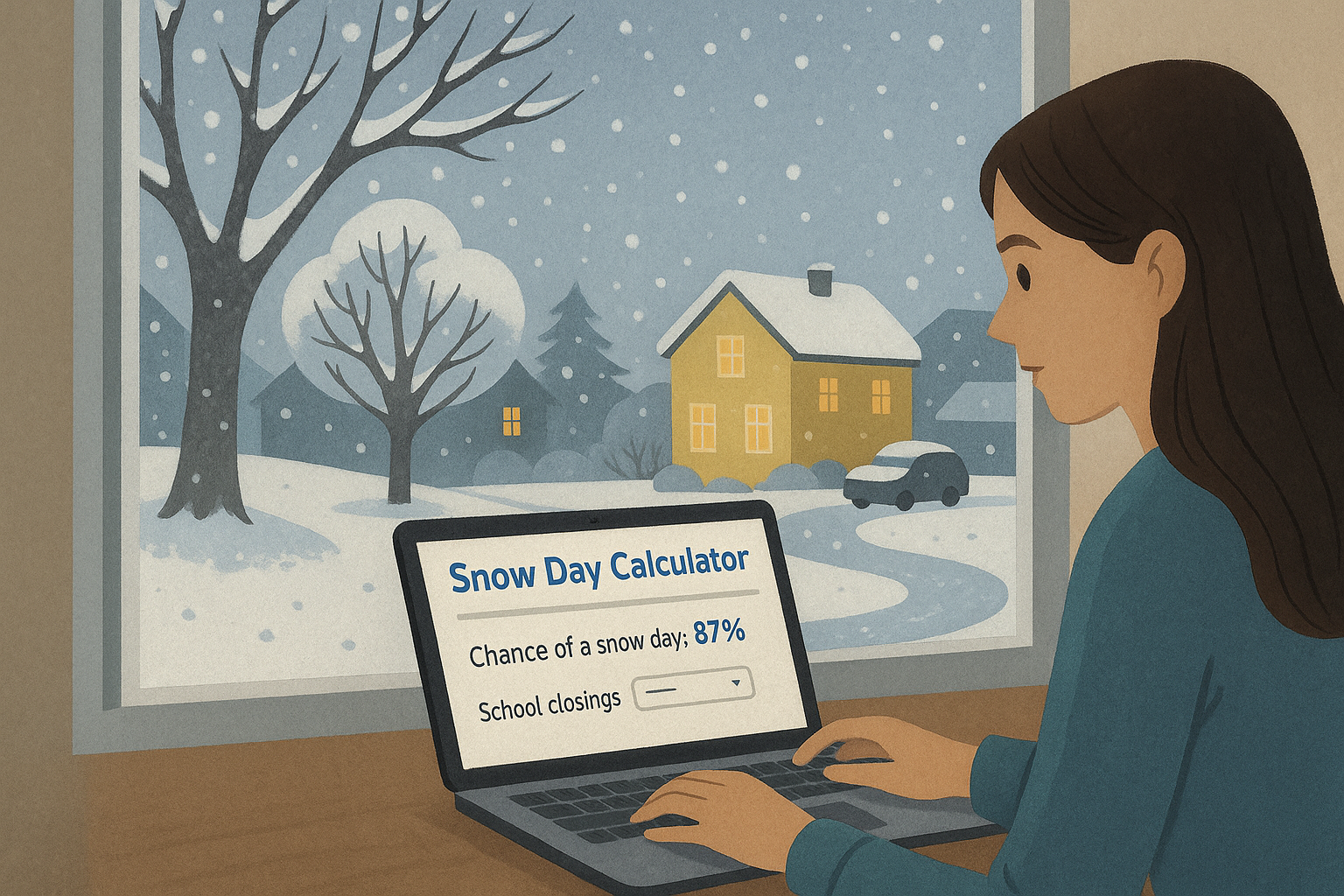Snow Day Calculator: 7 Reasons It’s Changing Winter

A snow day calculator is an online or app-based tool that predicts the chance of schools being closed due to snowstorms. It uses a combination of weather data, historical trends, and sometimes even school policies to make its forecast.
Most calculators ask users to enter a ZIP code, current snowfall forecast, and sometimes whether their school has closed in past years for similar storms. Once the inputs are in, the tool gives back a percentage score. That percentage shows how likely it is that schools in that area will cancel classes.
How It Works Behind the Scenes
Although it looks simple, the engine behind a snow day calculator is more complex. Weather data such as snow accumulation, wind speeds, temperature drops, and storm warnings are all factored in. Additionally, machine learning models may be used to learn from past decisions made by school districts.
Therefore, this technology doesn’t just rely on weather but adapts over time. For example, if a school has a history of staying open during light snow, the tool learns and adjusts its predictions.
Why Parents and Students Love It
For students, a snow day can mean staying in pajamas, drinking hot chocolate, and watching TV. That excitement makes them return to snow day calculators often during a stormy week. Parents appreciate the heads-up it provides. Instead of scrambling early in the morning to find out about closures, they can plan ahead.
Moreover, teachers use the calculator too. It gives them a better sense of whether to prepare a remote lesson, pack up homework to go, or update online portals.
The Role of Weather Forecast Accuracy
No tool is perfect, and the accuracy of any snow day calculator depends largely on the weather forecasts it’s using. If the forecast is off by even a few degrees or inches, predictions can change. However, most tools are updated hourly, so they reflect the most recent meteorological insights.
Still, the output should be seen as a helpful prediction, not a final decision. Only the school district can make the official call.
What Data Do These Tools Use?
Some of the most common data points include:
-
Snow accumulation: Measured in inches per hour
-
Temperature: Especially if it dips below freezing
-
Wind chill: Harsh wind can worsen safety risks
-
Time of snowfall: Overnight storms affect bus routes
-
Geography: Some areas handle snow better than others
-
Historical closures: Past actions help forecast future decisions
By analyzing these variables, the calculator gives a score that users can quickly understand.
Are Snow Day Calculators Always Right?
Not always. Sometimes schools remain open despite heavy snow because roads are clear. Other times, they close early even with only light flurries due to freezing rain. While these tools do their best, local school administrators must weigh many factors like bus safety, parking lot conditions, and sidewalk ice.
How to Use a Snow Day Calculator Effectively
To get the most out of the tool:
-
Use it the night before and again in the morning. Forecasts change.
-
Check multiple sources. Don’t rely on one prediction only.
-
Know your district’s tendencies. Some cancel faster than others.
-
Use common sense. If it’s blizzarding outside, there’s a good chance of a closure.
Best Snow Day Calculators to Try
Some popular options include:
-
Snow Day Predictor
-
Snow Day Calculator by David Sukhin
-
Snow-Closings.com
These are often free, and many are mobile-friendly. Some offer push notifications for updates too.
The Importance of Local Knowledge
A snow day calculator works best when it knows how your school district behaves. For example, a district in Boston may keep schools open through five inches of snow, while a southern town might cancel at one inch. Over time, calculators collect that behavior and improve their predictions.
Therefore, when selecting a calculator, choose one that asks about your school type or region.
School Policies and Flexibility
In the past, a snow day meant no school at all. Now, many districts offer virtual learning as a backup. So even if schools close, classes may still happen. Some calculators now include this as a possible outcome.
It’s useful for families to know not just if a day off is coming, but what type of day—completely off or virtual.
How Kids Use the Snow Day Calculator
Let’s be honest—kids might be the biggest fans. They’ll refresh the tool every hour hoping to see that sweet “99% chance” of a snow day. It gives them something to be excited about during a cold, gray week.
But it also teaches them how predictions work, how to use data, and even some weather science.
Is It Just for Students?
Not at all. Bus drivers, custodians, school nurses, and other staff use these tools as well. Since everyone’s routine is affected by snow, it helps them all plan ahead. Even after-school program managers rely on such forecasts.
How School Districts Make Their Decision
Even though a snow day calculator gives a score, the final decision is always made by district officials. These folks consider road conditions, reports from highway departments, and the risk for both buses and walkers.
Some schools also consult local meteorologists before making the call.
Does It Work for Colleges?
Yes, but not always. Since many college students live on campus and walk to class, snow days are rare. However, for commuter-heavy schools, closures still happen, and calculators can help predict those too.
Technology Behind Snow Day Calculators
Machine learning, big data, and real-time APIs (application programming interfaces) are used to create smart calculators. They aren’t just simple scripts—they process thousands of weather reports and school alerts to improve accuracy.
Should You Rely on It?
It’s great for planning, but always wait for your school’s official announcement. Use the calculator as a guide, not a guarantee.
Fun Tip: Create Your Own Snow Day Score
Here’s a DIY version for fun:
-
2 inches of snow: 20%
-
Add 20% for each extra inch
-
Add 10% if the storm is overnight
-
Subtract 15% if your school rarely closes
This playful method gives a rough estimate but can be surprisingly close.
Common Myths Debunked
-
Myth: “If my friend’s school closes, mine will too.”
Truth: Each district makes its own call. -
Myth: “100% chance means it will close.”
Truth: It’s a prediction, not a promise. -
Myth: “The calculator knows exactly what my school will do.”
Truth: It uses trends and data, but not insider info.
Why These Tools Are Useful
Even if they aren’t perfect, snow day calculators reduce stress, improve planning, and bring a little fun to winter weather. Whether you’re a parent preparing for daycare or a teacher organizing assignments, the calculator can give peace of mind.
The Rise of AI and Forecasting Tools
As artificial intelligence advances, calculators may soon predict snow days with even more accuracy. They might even integrate voice assistants or alerts directly into smartphones and watches.
Final Thoughts on Snow Day Calculators
The snow day calculator is more than a digital toy. It’s a sign of how smart tech can meet everyday needs. Although it doesn’t replace real-time alerts, it definitely adds excitement and convenience to stormy days. As technology improves, these tools will only become more useful—and more accurate.
Frequently Asked Questions
How accurate is a snow day calculator?
Most calculators are about 80% accurate when weather forecasts are reliable. Accuracy improves when local school behavior is considered.
Can I use the calculator for multiple ZIP codes?
Yes, most tools allow checking different regions, which is helpful for families with kids in different districts.
What time is best to check the calculator?
Check late evening and early morning. That’s when most school decisions are made and forecasts are updated.
Does snow day calculator work outside the U.S.?
Some tools are U.S.-based, but international users can still get estimates if the tool accepts foreign ZIP/postal codes.
Is there an app version of the snow day calculator?
Yes, some calculators have mobile apps for Android and iOS. They often offer push notifications.
Can schools cancel for ice, even with no snow?
Absolutely. Ice is dangerous for buses and walking. Calculators that include ice factors give better results.
Conclusion
Snow day calculators are not just helpful—they’re fun, educational, and practical. For students, teachers, and parents, knowing what to expect the next morning is priceless. With accurate data, useful insights, and tech improvements, these tools are set to become an essential winter resource.











